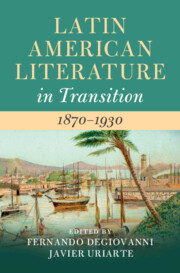Book contents
- Latin American Literature in Transition 1870–1930
- Latin American Literature in Transition
- Latin American Literature in Transition 1870–1930
- Copyright page
- Contents
- Figures
- Contributors
- Acknowledgments
- Introduction
- Part I Commodities
- Part II Networks
- Part III Uprisings
- Part IV Connectors
- Chapter 16 Money
- Chapter 17 Bodies
- Chapter 18 Travel
- Chapter 19 War
- Chapter 20 Science
- Chapter 21 Visual Technologies
- Part V Cities
- Index
- References
Chapter 21 - Visual Technologies
from Part IV - Connectors
Published online by Cambridge University Press: 14 January 2023
- Latin American Literature in Transition 1870–1930
- Latin American Literature in Transition
- Latin American Literature in Transition 1870–1930
- Copyright page
- Contents
- Figures
- Contributors
- Acknowledgments
- Introduction
- Part I Commodities
- Part II Networks
- Part III Uprisings
- Part IV Connectors
- Chapter 16 Money
- Chapter 17 Bodies
- Chapter 18 Travel
- Chapter 19 War
- Chapter 20 Science
- Chapter 21 Visual Technologies
- Part V Cities
- Index
- References
Summary
The turn of the century saw the emergence of a host of different entertainment media through which visual culture was industrialized, commodified, and otherwise modernized. New visual technologies, from photography, moving panoramas, stereoscopes, and cinema, to new image-delivery systems in advertisement and the illustrated press crystalized new forms of social organization and transformed visual perception. Following the modern crónicas of modernista writer Rubén Darío, the article explores the ways in which literary writing faced the challenge of the new mass culture and developed new languages and forms to reach a growing readership in the Latin American modernizing cities. Bridging both sides of the Atlantic and crossing over from the aesthete poet to the popular chronicler, Darío’s writing registers not just the intertwinement of high and mass culture, but above all the forms of spectatorship that delineated “the era of the mechanical reproducibility.”
- Type
- Chapter
- Information
- Latin American Literature in Transition 1870–1930 , pp. 307 - 324Publisher: Cambridge University PressPrint publication year: 2022

